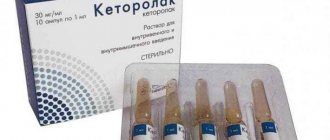pharmachologic effect
Antianemic drug for parenteral use.
After intramuscular administration of iron (III), polymaltosate hydroxide enters the bloodstream through the lymphatic system. From the plasma, the macromolecular complex enters the reticuloendothelial system, where it is broken down into iron hydroxide and polymaltose. The slow release of iron is the reason why it is well tolerated. In the liver it is included in hemoglobin, myoglobin and iron-containing enzymes, and is also deposited in the body in the form of ferritin. In the blood, iron binds to transferrin, in the bone marrow it is included in hemoglobin and used in the process of erythropoiesis.
It is well known that the incorporation of iron into protoporphyrin depends on the severity of iron deficiency anemia. It is intense in the case of low hemoglobin levels and decreases as hemoglobin levels normalize.
The response from blood parameters to parenteral iron administration is no faster than to oral administration of iron salts in patients in whom they are effective.
The degree of iron utilization cannot be higher than the iron-binding capacity of transport proteins.
Like other iron preparations, Maltofer has no effect on erythropoiesis and is ineffective for anemia not associated with iron deficiency.
Maltofer solution d/in. IM 50 mg/ml amp. 2ml №5 4043
Description
Maltofer® Takeda Pharmaceuticals Limited Liability Company (Japan) solution for intramuscular administration 50 mg/ml; ampoule 2 ml, cardboard pack 5; EAN code: 7680465379052; No. P N011981/02-2001, 2008-07-21 from Vifor (International) Inc. (Switzerland) Latin name Maltofer® Active ingredient Iron (III) hydroxide polymaltosatum (Ferri (III) hydroxydum polymaltosatum) ATC: B03AC01 Iron oxide polymaltose complexes Pharmacological groups Iron preparation [Macro- and microelements] Hematopoiesis stimulants Nosological classification (ICD-10) D50 Iron deficiency anemia D63.0 Anemia in neoplasms (C00-D48+) E61.1 Iron deficiency Description of the dosage form Brown solution. Pharmacological action Pharmacological action - replenishing iron deficiency. Pharmacodynamics After intramuscular administration, iron released from the active component - iron (III) hydroxide polymaltosate - is absorbed mainly by the liver. It is then incorporated into hemoglobin, myoglobin and iron-containing enzymes, and is also stored in the body as ferritin. The response in blood parameters is no faster with parenteral iron than with oral iron salts in patients in whom they are effective. Like other iron preparations, Maltofer® has no effect on erythropoiesis and is ineffective for anemia not associated with iron deficiency. Pharmacokinetics After intramuscular administration, the complex enters the bloodstream through the lymphatic system. Cmax of iron in blood plasma is reached approximately 24 hours after injection. From the blood plasma, the macromolecular complex enters the reticuloendothelial system, where it is split into components - polynuclear iron hydroxide and polymaltose (metabolized by oxidation). The slow release of iron is the reason why it is well tolerated. In the bloodstream, iron binds to transferrin, in tissues it is stored as part of ferritin, in the bone marrow it is included in hemoglobin and participates in the process of erythropoiesis. Only small amounts of iron are excreted from the body. In small quantities, the unchanged complex can pass through the placental barrier, and small amounts pass into breast milk. Iron bound to transferrin can cross the placental barrier and, as part of lactoferrin, enters breast milk in small quantities. There are no data on the pharmacokinetics of the drug in patients with iron deficiency anemia. It is well known that iron absorption depends on the severity of iron deficiency anemia. It is intense in the case of low hemoglobin and decreases as hemoglobin normalizes. The degree of iron utilization cannot be higher than the iron-binding capacity of transport proteins. The effects of renal and hepatic impairment on the pharmacological properties of iron(III) hydroxide polymaltosate are unknown. The toxicity of the drug is very low. LD50 determined for white mice with intravenous administration of the drug Maltofer® was >2500 mg/kg of iron, which is 100 times lower than for simple iron salts. Indications for the drug Maltofer® Iron deficiency anemia with ineffectiveness or impossibility of taking iron supplements orally (including in patients with gastrointestinal diseases and malabsorption syndrome). The drug is administered intramuscularly only in cases of iron deficiency confirmed by appropriate studies (for example, measurement of serum ferritin, hemoglobin (Hb), hematocrit or red blood cell count, as well as their parameters - average red blood cell volume, average Hb content in red blood cells or average Hb concentration in red blood cells) . Contraindications: hypersensitivity; anemia not associated with iron deficiency (hemolytic, megaloblastic, caused by vitamin B12 deficiency); erythropoiesis disorders; bone marrow hypoplasia; excess iron in the body (hemochromatosis, hemosiderosis); impaired iron utilization (sideroachrestic anemia, thalassemia, lead anemia, cutaneous porphyria tarda); Osler-Rendu-Weber syndrome; chronic polyarthritis; bronchial asthma; infectious kidney diseases in the acute stage; uncontrolled hyperparathyroidism; decompensated cirrhosis of the liver; infectious hepatitis; use for intravenous administration; I trimester of pregnancy; children under 4 months of age (experience with the drug is limited). With caution: impaired renal and/or liver function. Use during pregnancy and breastfeeding Clinical data on the use of the drug in pregnant women is currently insufficient. Animal studies have not examined the reproductive toxicity of the drug. During pregnancy, the drug should be used only if the expected benefit to the mother outweighs the potential risk to the fetus and/or child. The use of the drug in the first trimester of pregnancy is contraindicated. In small quantities, unchanged iron from the polymaltose complex can pass into breast milk. If it is necessary to use the drug during lactation, breastfeeding should be stopped. Side effects Rare - possible arthralgia, swollen lymph nodes, fever, headache, dyspepsia (nausea, vomiting). Very rarely - allergic or anaphylactic reactions are possible. Local reactions (if the drug is administered incorrectly): skin coloring, pain at the injection site, inflammation. Interaction Like all other iron preparations, Maltofer® should not be used simultaneously with iron-containing preparations for oral administration, since absorption of the latter from the gastrointestinal tract is reduced. Therefore, treatment with iron-containing oral preparations should begin no earlier than 1 week after the last injection of Maltofer®. Concomitant use of ACE inhibitors (eg enalapril) may increase the systemic effects of parenteral iron preparations. Overdose Symptoms: To date, no cases of iron overdose have been reported. Overdose can cause acute iron overload, which manifests itself as symptoms of hemosiderosis. Treatment: it is recommended to use symptomatic agents and, if necessary, iron-binding substances (chelates), such as deferoxamine (iv). Special instructions Before use, the ampoule should be inspected for sediment and damage. Only ampoules without sediment or damage can be used. After opening the ampoule, Maltofer® should be administered immediately. Maltofer® should not be mixed with other medications. Parenteral iron supplements can cause allergic and anaphylactic reactions. In case of moderate allergic reactions, antihistamines should be prescribed; If a severe anaphylactic reaction develops, immediate administration of epinephrine (adrenaline) is necessary. Cardiopulmonary resuscitation must be available. Caution should be exercised when administering the drug to patients with allergies, as well as liver and kidney failure. Side effects that occur in patients with cardiovascular diseases can aggravate the course of the underlying disease. Patients with bronchial asthma or those with low serum iron-binding capacity and/or folic acid deficiency are at high risk of developing allergic or anaphylactic reactions. Administration to children under 4 months of age is not recommended due to lack of experience. In children, parenteral iron supplements can negatively affect the course of the infectious process. Impact on the ability to drive vehicles and machinery. Not studied. Release form Solution for intramuscular administration, 50 mg/ml: in colorless transparent glass ampoules (type I according to the European Pharmacopoeia), with a notch and technical color marks in the form of a rim and a dot on the neck of the ampoule, 2 ml each. 5 amp. in PVC blister packaging. 1 or 20 cell packs are placed in a cardboard box. Manufacturer Nycomed GmbH, Robert-Bosch-Strasse 8, 78224 Singen. Marketing authorization holder: Vifor (International) Inc. Rechenstrasse 37, CH-9014, St. Gallen, Switzerland. e-mail: [email protected] Organization receiving claims: Nycomed Distribution Cente LLC. 119048. Moscow, st. Usacheva, 2, building 1. Tel.: +7; Fax. e-mail: [email protected] ; Internet: www.nycomed.ru. Conditions for dispensing from pharmacies By prescription. Storage conditions for Maltofer®: Protected from light, at a temperature not exceeding 25 °C. In original packaging. Keep out of reach of children. The shelf life of Maltofer® is 5 years. Do not use after the expiration date stated on the package. 2000-2015. Register of Medicines of Russia The database is intended for healthcare professionals. Commercial use of materials is not permitted.
Possible product names
- Maltofer solution d/in. IM 50 mg/ml amp. 2ml No.5
- MALTOFER 50 MG/ML 2 ML AMP. No. 5
- MALTOFER 5% 2ML N5 AMP
- MALTOFER SR IM INSTRUCTION 50 MG/ML AMP. 2 ML X 5
- MALTOFER SOLUTION FOR IM INJECTION. 50MG/ML AMP. 2ML No. 5
- Maltofer solution d/in 50 mg/ml 2 ml Amp. X5 B! until 05.10/
- (Maltofer) Maltofer solution d/in. IM 50 mg/ml amp. 2ml No.5
- MALTOFER RR D/IN. IM 50 MG/ML AMP. 2 ML No. 5
Indications for use
Treatment of iron deficiency in case of insufficient effectiveness, ineffectiveness or impossibility of oral administration of iron-containing drugs, including:
- with malabsorption;
- in patients who do not agree to long-term and regular use of oral iron supplements;
- in patients with gastrointestinal diseases (for example, ulcerative colitis), in whom oral iron supplements can provoke an exacerbation of the disease.
Maltofer for injection is used only in cases of iron deficiency confirmed by appropriate studies (for example, determination of the level of serum ferritin, hemoglobin, hematocrit or red blood cell count, as well as their parameters - average red blood cell volume, average hemoglobin content in a red blood cell).
Side effects and overdose
Among the side effects in terms of frequency of occurrence are: arthralgia, enlarged lymph nodes, increased body temperature, malaise, and gastrointestinal disorders. The above conditions can be treated with symptomatic therapy.
Taking into account individual intolerance to the drug, the development of allergic manifestations, including the development of anaphylactoid-type reactions, is possible.
Around the injection site the following may be observed: hyperemia, soreness, change in skin color. In this case, it is necessary to differentiate the manifestations of the consequences of injection from post-injection inflammatory (purulent-necrotic) skin diseases.
An overdose of Fe preparations often has the consequences of a chronic (long) period of use - when the level of demand is exceeded above the level of absorption and elimination from the body. Correct formulation of a working diagnosis and taking into account concomitant diseases require special attention. Monitoring the effectiveness of therapy and the critically applied dose is carried out by periodically measuring the level of laboratory parameters of the same list as before the start of treatment.
Severe forms of overdose are manifested by clinical symptoms of hemosiderosis with appropriate treatment.
Directions for use and doses
The drug is administered intramuscularly.
Before the first administration of a therapeutic dose, it is necessary to conduct an intramuscular test: adults are administered from 1/4 to 1/2 doses of the drug (from 25 to 50 mg of iron (0.5-1 ml)), children from 4 months - half the daily dose. In the absence of adverse reactions, the remainder of the initial dose of the drug can be administered within 15 minutes after administration.
During the injection, it is necessary to ensure the availability of funds to provide emergency assistance in the event of anaphylactic shock.
The dose of the drug is calculated individually and adapted in accordance with the general iron deficiency
Instructions for use
The dosage regimen and timing of the course of treatment depend on the individual deficiency of Fe in the body. In order to determine the drug therapy regimen, before starting treatment, serum ferritin levels and red blood parameters (number of red blood cells, hemoglobin, erythrocyte indices: MCV, MCH) are calculated in the laboratory. This is followed by the calculation and adaptation of the required daily dose of the drug equivalent to iron. Both the initial deficiency and the daily requirement are taken into account. Dose adaptation implies the frequency and volume of the administered dose of the drug.
Estimated iron deficiency (mg) = body weight (kg) × (estimated hemoglobin level (g/l) – detected hemoglobin level (g/l)) × 0.24 + depot iron level (500 mg).
If the calculated dose of deficiency (mg) exceeds the maximum permissible daily dose, it is divided into equal volumes of administration, thereby increasing the frequency of injections.
Maximum permissible daily doses of the drug: children up to 5 kg in weight – 0.5 ml/25 mg; children over 5 kg but less than 10 kg in weight – 1.0 ml/50 mg; adults – 4.0 ml/200 mg.
The drug can only be administered intramuscularly.
Features of drug administration and therapy are described in the “Special Instructions” section.
Contraindications
- anemia not associated with iron deficiency (for example, hemolytic anemia, megaloblastic anemia caused by vitamin B12 deficiency, disorders of erythropoiesis, bone marrow hypoplasia);
- excess iron (i.e. hemochromatosis, hemosiderosis);
- impaired iron utilization (for example, sideroachrestic anemia, thalassemia, lead anemia, cutaneous porphyria tarda);
- Osler-Rendu-Weber syndrome; chronic polyarthritis;
- bronchial asthma;
- infectious kidney diseases in the acute stage;
- uncontrolled hyperparathyroidism;
- decompensated cirrhosis of the liver;
- infectious hepatitis;
- I trimester of pregnancy;
- intravenous administration;
- hypersensitivity to the components of the drug.
special instructions
Parenteral iron supplements can cause allergic and anaphylactic reactions. In case of moderate allergic reactions, antihistamines should be prescribed; If a severe anaphylactic reaction develops, immediate administration of epinephrine (adrenaline) is necessary. When administered, it is necessary to ensure the availability of cardiopulmonary resuscitation equipment.
The drug should be administered with caution to patients with allergies, as well as liver and kidney failure.
Side effects that occur in patients with cardiovascular diseases can aggravate the course of the underlying disease.
Patients with bronchial asthma or those with low serum iron-binding capacity and/or folic acid deficiency are at high risk of developing allergic or anaphylactic reactions.
Before using the drug, ampoules should be inspected for sediment and damage. You can only use ampoules without sediment or damage. After opening the ampoule, the injection solution should be administered immediately.
Maltofer for injection should not be mixed with other therapeutic drugs.
It is not recommended to prescribe the drug to children under 4 months of age due to the lack of experience with this category of patients.
Composition and release form
The manufacturer of the described drug is the Swiss pharmaceutical company Vifor International Incorporated.
The solution for injection "Maltofer" based on the active substance contains an oligosaccharide (maltose) with iron (III) hydroxide.
Excipients (stabilizers): sodium hydroxide and hydrochloric acid. They make it possible to obtain water-soluble complexes with an acidity in the range of 5.2-6.5. The acid-base balance of the drug is shifted to a slightly alkaline environment.
The main solvent of the resulting drug is water for injection. Its content is determined by the volume of the injection solution.
Release form: sterile solution for intramuscular injection, which does not require additional dilution before administration. The volume of ampoules is 2 ml, which is equivalent to 100 mg of elemental iron. The package contains five vessels.




